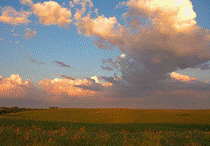
Proceedings of the North American Prairie Conferences
Date of this Version
2004
Document Type
Article
Abstract
We conducted studies in native prairie mixed-grass pastures in south~central North Dakota (U.S.A.) during 1989- 2003 to determine how different grazing intensities affected structural characteristics of vegetation, livestock production and the occurrence and density of grassland birds. Generally, as grazing treatment intensity increased from light to extreme, mean vegetation structural values decreased for visual obstruction readings, tallest plants of grasses, forbs, and shrubs, and litter depth. Nineteen species of non-game birds were detected during 2001 and 2002. Overall breeding bird densities were negatively affected by increasing levels of grazing intensity in mixed-grass prairie. Claycolored sparrows (Spizella pallida), grasshopper sparrows (Ammodramus savannarum) , and savannah sparrows (Passrculus sandwichensis) reached their highest densities in the light and moderate grazing intensity treatments whereas they occurred at very low densities or were absent from extreme grazing intensity treatments. In contrast, densities of chestnut-collared longspurs (Calcarius omatus), horned larks (Eremophila alpestris), upland sandpipers (Bartramia longicauda), marbled godwits (Limosa fedoa) , and willets (Catoptrophorus semipalmatus) were highest in the heavy and extreme grazing treatment plots. Livestock average daily weight gains and body condition scores decreased directly with increasing grazing intensity. In contrast, average red meat production gains per unit of pasture had a quadratic relationship to stocking rates, increasing with increased grazing intensity (more animals per unit of pasture) until it reached a peak and then declined. Results from this study suggest that management of grassland habitats can be manipulated under specific grazing intensities to provide predictable conditions of nesting habitat for grassland bird species of management concern. Collectively, our results support that stocking rates equal to or nearly equal to our light to moderate grazing intensity treatments would provide habitat for most species of non-game birds nesting in mixed-grass prairies and still enable ranchers to obtain a profit from livestock production.


Comments
Published in Dave Egan & John A. Harrington, editors, Proceedings of the 19th North American Prairie Conference: The Conservation Legacy Lives On..., University of Wisconsin-Madison, August 8-12, 2004 (Proceedings of the North American Prairie Conference, 19), Madison, WI: University of Wisconsin-Madison, 2004.